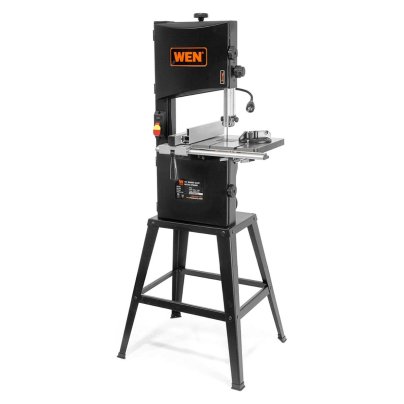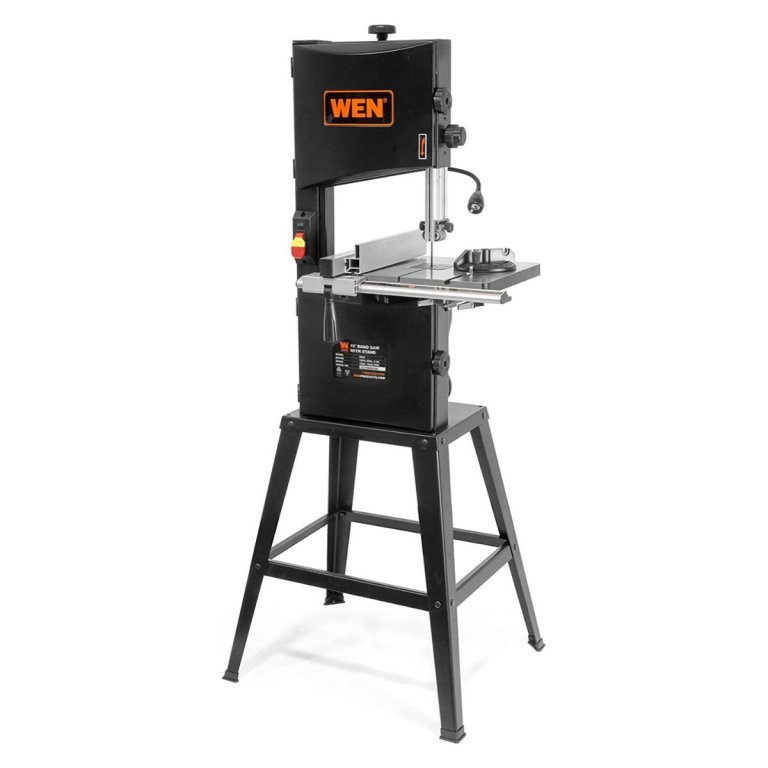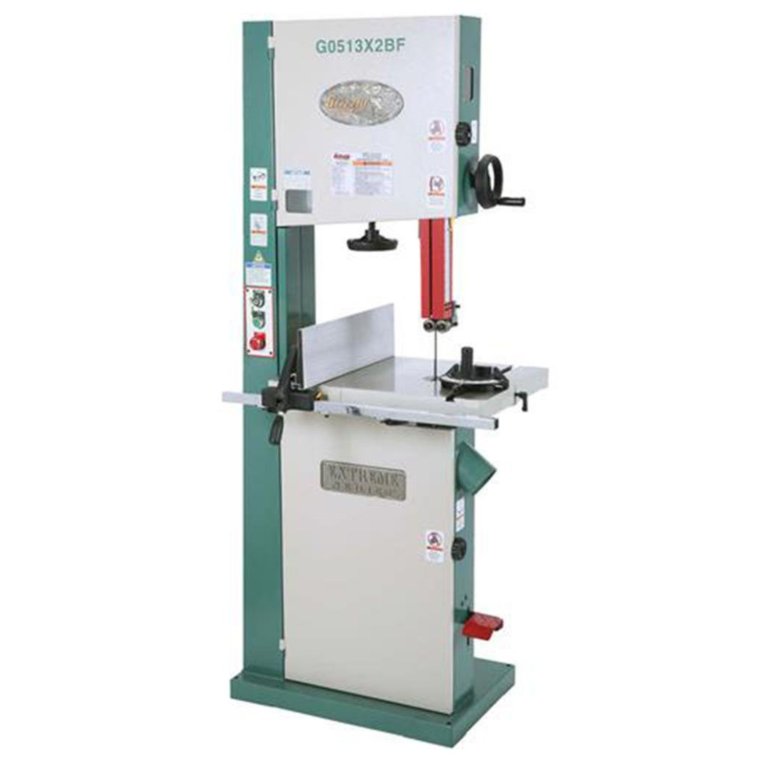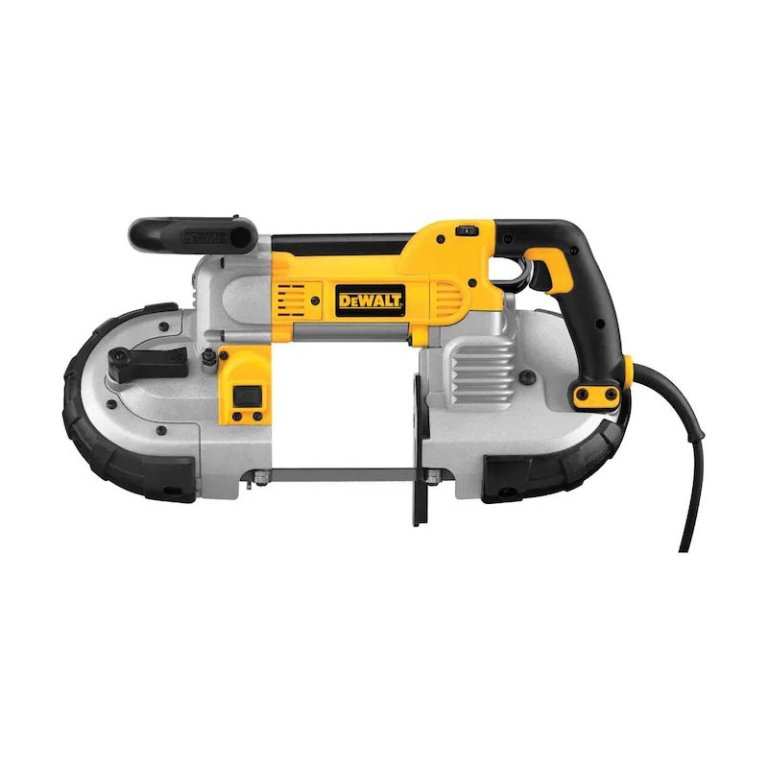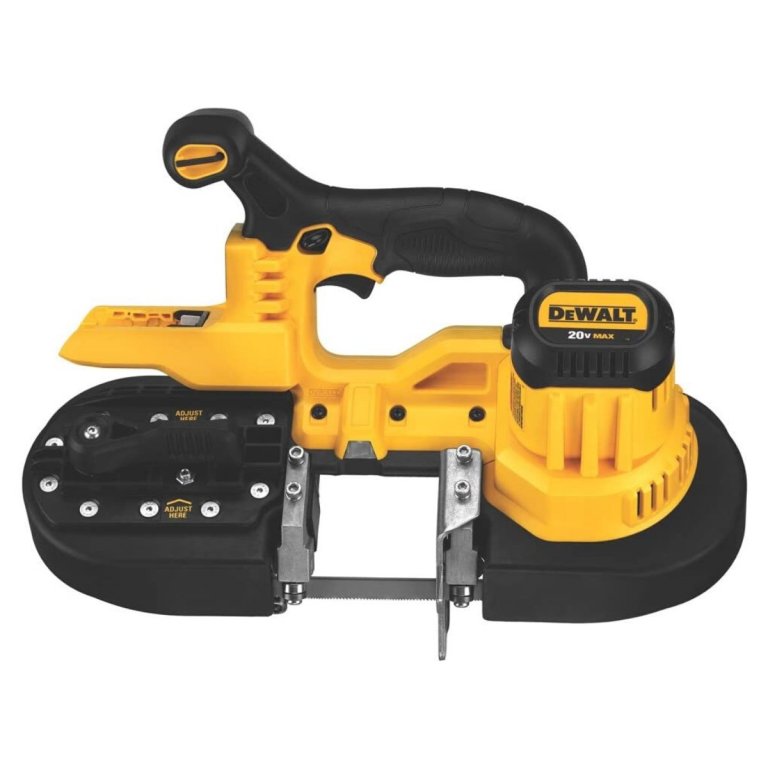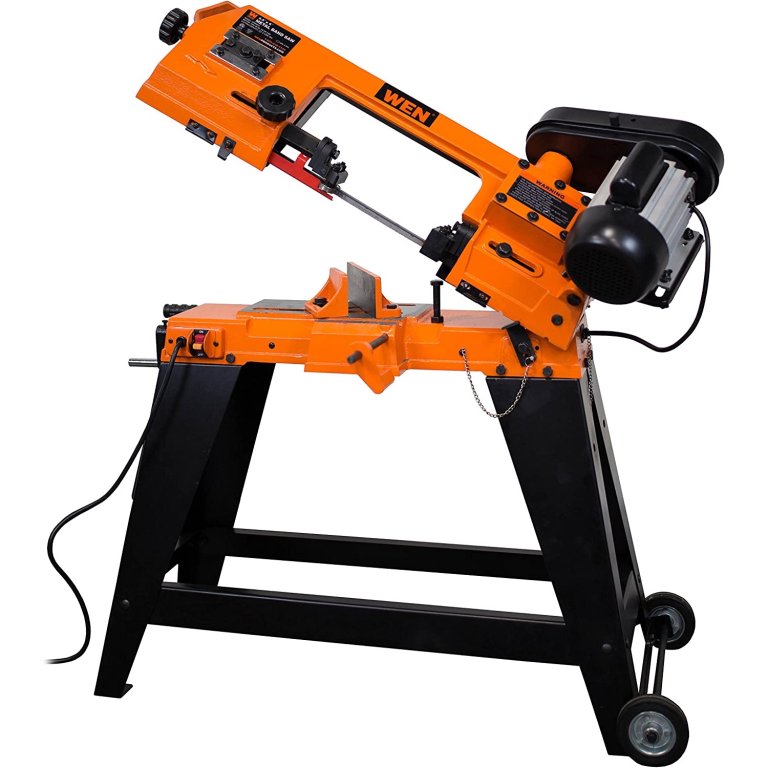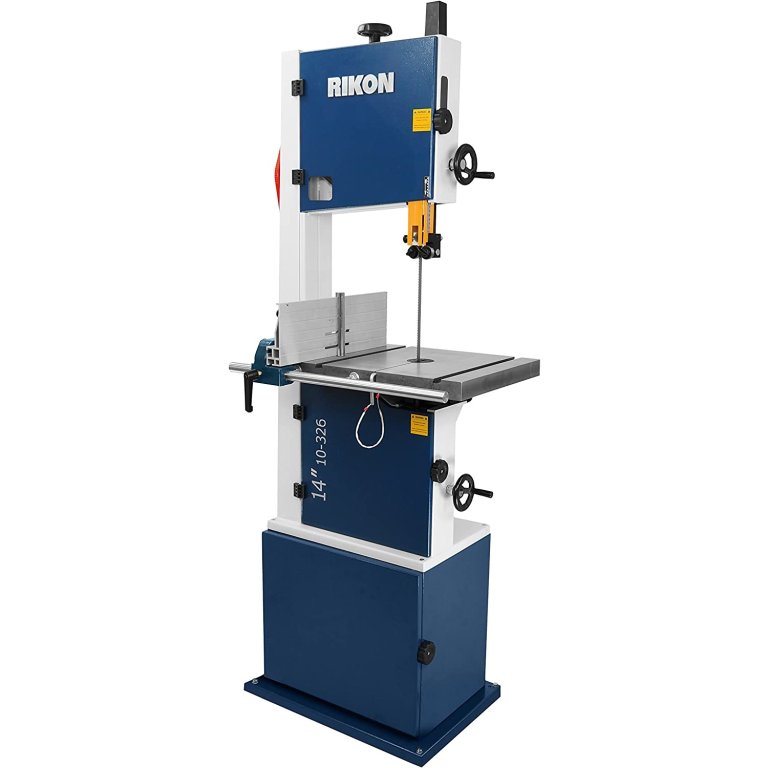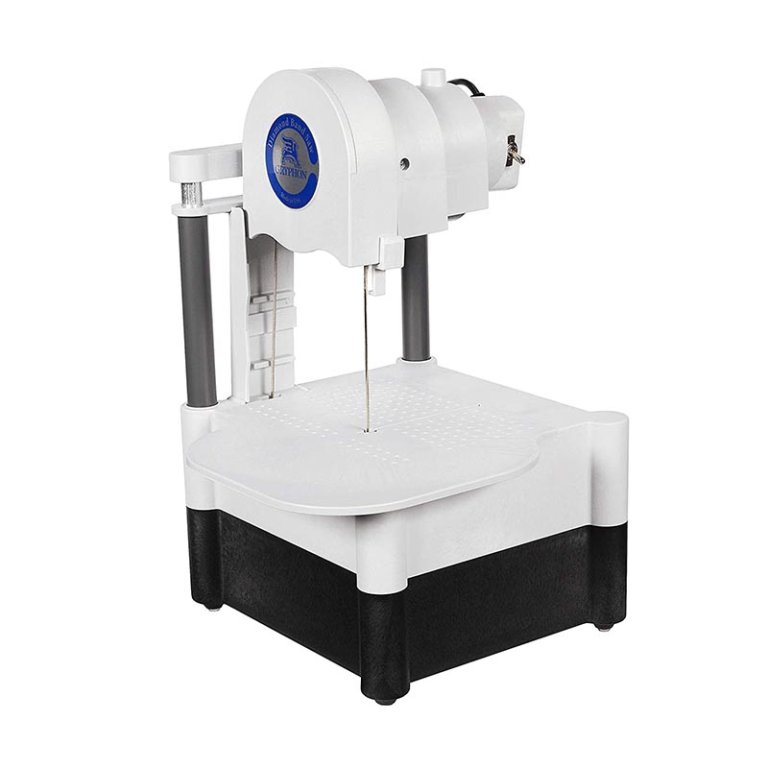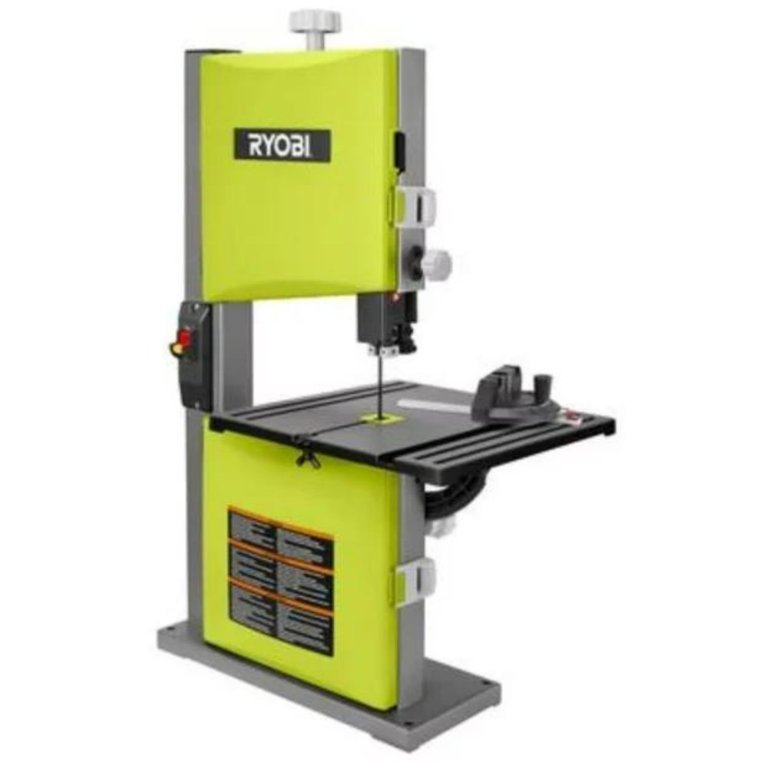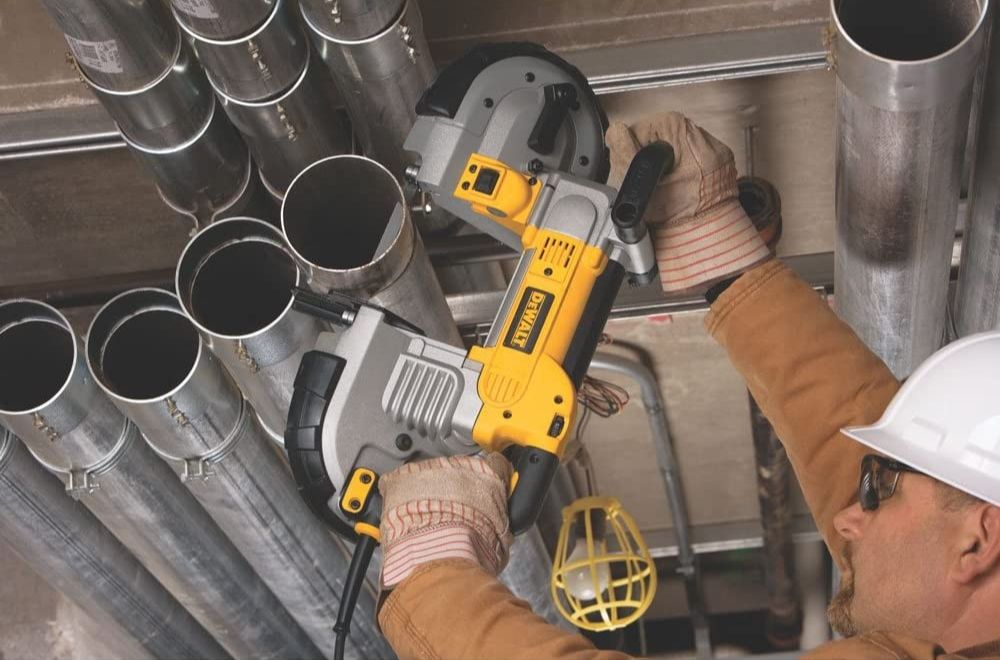
We may earn revenue from the products available on this page and participate in affiliate programs. Learn More ›
A sturdy band saw makes rip cuts like a table saw, crosscuts like a miter saw, and reduces the thickness of a board like a planer. With the right band, these tools cut metal, too. Band saws do intricate work to speed workflow and improve overall results, which might just make them one of the most important saws for a DIYer.
We recommended the Wen 3962 10-Inch Two-Speed Band Saw With Stand as our best overall pick because of its large capacity, adjustable rip fence, and 3.5-amp motor. But before you upgrade your workshop with a new power tool, read this guide for tips and descriptions of the best band saws, some of which went through our hands-on testing.
- BEST OVERALL: Wen 3962 10-Inch Two-Speed Band Saw with Stand
Jump to Review - RUNNER-UP: Grizzly Industrial 17-Inch Extreme-Series Band Saw
Jump to Review - BEST BANG FOR THE BUCK: DeWalt 10 Amps 4.75-Inch Portable Band Saw
Jump to Review - BEST PORTABLE: Milwaukee M18 Fuel Cordless Deep Cut Band Saw
Jump to Review - BEST CORDLESS: DeWalt DCS371B 20V MAX Band Saw
Jump to Review - BEST FOR METAL: Wen BA4664 Metal-Cutting Band Saw with Stand
Jump to Review - BEST FOR WOOD: Rikon Power Tools 10-326 14-Inch Deluxe Band Saw
Jump to Review - BEST FOR GLASS: Gryphon 37-Inch AquaSaw XL Diamond Band Saw
Jump to Review - BEST FOR RESAWING: Ryobi 2.5-Amp 9-Inch Corded Band Saw
Jump to Review
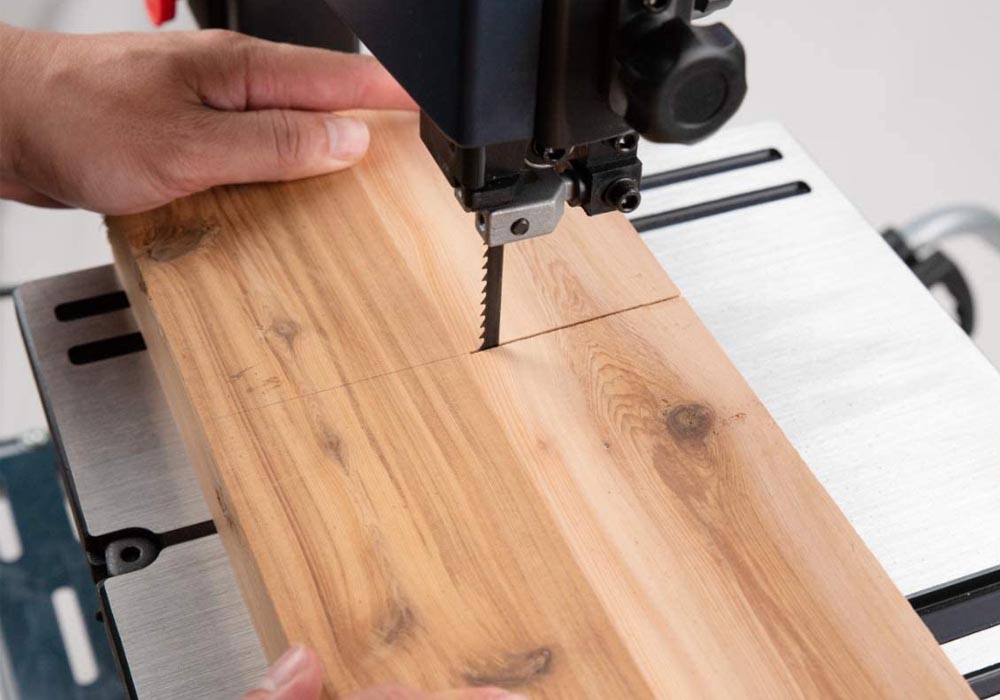
How We Chose the Best Band Saws
Though DIY and industrial band saws are relatively simple tools, a lot goes into putting together a list of the best options out there. I performed extensive product research and hands-on testing and drew on my own experience in order to put together this guide.
First, I compared the cost to features to make sure that each model’s features and capabilities lived up to its price tag. Next, I looked at the power relative to the model’s size to make sure the saw could handle the intended tasks. Select models were also put through hands-on testing by Bob Vila editors, the results of which are included below. Finally, each of the models that made it through vetting earned an award based on its most predominant strengths and weaknesses.
Our Top Picks
Band saws are about as old-school as it gets. While they’ve been around for more than 200 years at sawmills, workshops, and furniture shops, it takes a lot of consideration to select a band saw for personal use. This guide rounds up best-in-class types of saws that we discovered and/or hands-on tested to help cut out some of the guesswork.
Best Overall
Wen 3962 10-Inch Two-Speed Band Saw With Stand
Pros
- Built-in multisize dust-collection port helps reduce dust and particles in the air
- Large vertical capacity can accommodate a variety of bandsaw projects
- The large cast-aluminum worktable can bevel up to 45 degrees for precision
- Comes with an adjustable rip fence and miter gauge for added user-friendliness
Cons
- Bearing requires effective dust-collection system; may need to be purchased separately
Product Specs
- Style: Floor-standing
- Cutting capacity: 6 inches
- Power: 3.5 amp
Wen’s reasonably priced 3962 two-speed band saw includes a lot of premium features. The 10-inch band saw runs on a 3.5-amp motor, uses a 72-inch blade, and offers up to 6 inches of cutting capacity. With speeds of either 1,520 or 2,620 revolutions per minute (rpm), the saw adjusts to cut different types of wood. The saw table, which includes an adjustable rip fence and miter gauge, swivels up to 45 degrees to help make cuts at challenging angles.
A three-in-one dust collection port accommodates three different hose sizes—1.75 inches, 2.75 inches, and 4 inches—to ensure compatibility with most collection systems. Just be sure to use the dust collection system when running this saw, as the bearings on this wood band saw are susceptible to damage from dust.
Get the Wen 3962 band saw at Amazon or The Home Depot.
Runner-Up
Grizzly Industrial 17-Inch Extreme-Series Band Saw
Pros
- Comes with multiple user-friendly features; 6 accessories and tools included
- Table tilts for mitered cuts—5 degrees to the left and 45 degrees to the right
- 12-inch cutting capacity for DIY woodworking or industrial-grade cutting
- Motor brake shuts down in 3 seconds or less for added safety
Cons
- Only operates at a single speed; not as versatile or accommodating as other band saws
Product Specs
- Style: Benchtop
- Cutting capacity: 12 inches
- Power: 2 horsepower (hp)/8.7 amps
Those shopping for a band saw to tackle DIY woodworking projects as well as heavy-duty tasks might want to take a look at the Grizzly Industrial benchtop band saw. Its 2 hp motor holds 8.7 amps of power and has a 12-inch cutting capacity and a 16.25-inch throat for multiple cutting types. It also features a deluxe fence, an extra-wide cast-iron table, a heavy-duty miter gauge, dual 4-inch dust ports, micro-adjusting geared table, and double ball-bearing blade guides for ample ease of use. Plus, this pick has a larger table tilt that can move 5 degrees to the left and 45 degrees to the right.
For added safety, this large woodworking bandsaw has a motor brake that shuts down in 3 seconds to prevent unwanted cutting. Operators can simply use the foot pedal to activate the electronic brake as well as the manual brake so they can keep their hands on the table or wood at all times. To ensure high quality, this Grizzly band saw also comes with an ISO 9001 factory designation for long-term use.
Get the Grizzly Industrial band saw at The Home Depot, or Walmart.
Best Bang For The Buck
DeWalt DWM120 4.75-Inch Deep Cut Portable Band Saw
Pros
- Varying speeds for cutting tasks; 100 to 350 SFPM for DIY or professional use
- Long battery life compared to other battery-powered models
- Suitable for use on multiple materials: wood, metal, and more
- An onboard LED light adds ample visibility for precise cuts
Cons
- Blades may need to be replaced for heavy-duty cuts or long-term use
Product Specs
- Style: Portable
- Cutting capacity: 5 inches
- Power: 10 amps
For anyone with a project that requires cutting a lot of metal or pipe, this portable DeWalt band saw makes a great option. Instead of tiring out with a hacksaw or rattling fillings loose with a Sawzall, this model makes quick, smooth cuts in a range of materials. And, with the corded 10-amp motor, users need not worry about batteries dying mid-cut.
This portable band saw cuts at varying speeds between 100 and 350 surface feet per minute (SFPM), which allows the user to adjust for metal, wood, or other materials on the fly. It can handle up to a 5-inch cut, which works well for most job sites and workshop projects. An onboard LED makes a nice visibility bonus for safer work conditions. Just don’t judge this saw by how the included, low-quality blade cuts: Simply upgrade to a higher quality blade to realize this saw’s true potential.
Get the DeWalt DWM120 band saw at Lowe’s.
Best Portable
Milwaukee M18 Fuel Cordless Deep Cut Band Saw
Pros
- Large cutting capacity for heavy-duty cutting tasks; suitable for large or thick pieces of work
- Adjustable speeds up to 380 SFPM; cuts quicker than many other models available
- Dual-action trigger provides excellent reliability and control when in use
- Brushless motor for power extends battery life for long-term use
Cons
- Batteries are expensive to buy or replace; not included with purchase
Product Specs
- Style: Cordless
- Cutting capacity: 5 inches
- Power: 18 volts
Milwaukee’s 2729-20 cordless portable band saw rivals many corded tools. It offers a maximum width and depth of 5 inches and a brushless motor that spins the 14-TPI (teeth per inch) metal-cutting blade at speeds up to 380 SFPM while making efficient use of the batteries. It also some with a dual-action trigger
A safety switch prevents accidental activation, and a built-in hanging hook helps keep it safely out of the way when this mini band saw is not in use. Like many of its competitors, Milwaukee sells its band saw as a bare tool. The recommended pair of RedLithium batteries don’t come cheap, but they provide the kind of all-day running power typically required.
What our tester says: Glenda Taylor, a Bob Vila writer and product tester, notes in The Best Portable Band Saw that “the M18 Fuel is considered compact, although we found some full-size features on this tool. The M18 Fuel comes with dual handles and a speed-adjustment dial. It’s ergonomically designed—the trigger handle comes with a nonslip grip and the second handle has a pummel knob. We timed the tool, and it took 7 seconds to cut through a standard ⅝-inch rebar.”
Get the Milwaukee band saw at Amazon, Ace Hardware, or The Home Depot.
Best Cordless
DeWalt DCS371B 20V MAX Band Saw
Pros
- Works with the brand’s 20V MAX batteries for added versatility; compatible with multiple DeWalt products
- Lightweight at only 1 pound without the battery; suitable for transporting or moving around the workshop
- High-speed cutting capacity can tackle heavy-duty cutting quickly; provides 570 SFPM
- Tool-free blade change provides safety and convenience for the user
Cons
- Smaller cut capacity than some competitors; may not tackle large or thick pieces of wood well
Product Specs
- Style: Cordless
- Cutting capacity: 2.5 inches
- Power: 20 volts
A tangled cord can make an awkward cut impossible. But that won’t happen with DeWalt’s 20V MAX Band Saw. It runs on a lithium battery (not included) for cord-free woodworking. For those already invested in the DeWalt 20V MAX battery power tools, this band saw accepts the same batteries
The lightweight, small band saw weighs about 8 pounds (with the battery) and offers a 2½-inch cut capacity. Speedy for a portable band saw, it covers up to 570 SFPM. Tool-free blade changes have users back in business in no time.
Get the DeWalt DCS371B band saw at Amazon or Walmart (tool only).
Best For Metal
Wen BA4664 Metal-Cutting Band Saw With Stand
Pros
- Adjustable speed for a variety of materials and cutting tasks; suitable for aluminum, copper, steel, and more
- Cutting capacity up to 4.5-inch diameter metal pipes or up to 4-inch-by-6-inch rectangular materials
- Smooth cutting action reduces fatigue and vibration for user-friendliness
Cons
- Comes with a low-quality blade; may require a replacement
Product Specs
- Style: Corded
- Cutting capacity: 4.5 inches
- Power: 4.6 amps
If you’re looking for a band saw to add to your home metal shop, the BA4664 4-inch-by-6-inch Metal-Cutting Band Saw from Wen is worth checking out. This heavy-duty band saw has a 4.6-amp motor that produces ¾ horsepower. It has three adjustable speeds: 80, 120, and 200 feet per minute.
The BA4664 has an automatic shutoff that engages when the blade cuts through the metal. It also makes bevel cuts between 0 and 45 degrees, allowing you to create perfect metal joints. You also can stand the saw up vertically and use it as a standard band saw.
Get the Wen BA4664 band saw at Amazon, Lowe’s, or The Home Depot.
Best For Wood
Rikon Power Tools 10-326 14-Inch Deluxe Band Saw
Pros
- Adjustable speed for a variety of materials and cutting types; 1.75 hp motor delivers 1,445 SFPM to 2,950 SFPM
- Extra-tall fence provides a stable base for resawing when necessary; suitable bandsaw for woodworking
- All necessary adjustments are toolless for user-friendliness and safety
- Spring-loaded toolless guide system provides safety and peace of mind
Cons
- Tilt feature is hard to adjust and may take some elbow grease to move
Product Specs
- Style: Benchtop
- Cutting capacity: 13 inches
- Power: 1.75 hp
If you’re looking at band saws for wood that can handle some serious lumber, the Rikon 10-326 may be your solution. This band saw can handle cuts up to 13 inches, and the 1.75 hp motor has all of the power you’ll need to slice through thick slabs, so woodworkers can enjoy ripping through seasoned hardwoods with ease.
The extra-tall fence also adds a stable base for resawing lumber and hardwoods, and all adjustments are tool-less, including adjusting speeds from 1,445 SFPM to 2,950 SFPM. The unit also has a spring-loaded toolless guide system for added safety.
Get the Rikon Power Tools band saw at Amazon.
Best for Glass
Gryphon 37-Inch AquaSaw XL Diamond Band Saw
Pros
- Corrosion-resistant construction for long-term use and ample durability
- Diamond blade specifically for glass; will not break or wear over time or under heavy-duty use
- Large work surface for cutting glass sheets or large pieces of glass
Cons
- Not a heavy-duty machine; not suitable for cutting hard glass items
Product Specs
- Style: Benchtop
- Cutting capacity: Adjustable
- Power: Corded
Crafters looking to take their glass game to the next level should check out Gryphon’s AquaSaw XL band saw. It comes with a diamond blade for cutting glass bottles or sheets for stained glass and other projects. It has a large work surface with perforations for glass dust to fall through.
This tabletop band saw features corrosion-resistant materials like anodized aluminum and stainless steel, which allows the user to cut through beach glass and even coral without worrying about rust or damage. The design includes a direct-drive motor free from pulleys or belts for easier maintenance as well. Do beware, though, that this saw is solely for glass crafters. It is not for cutting wood or metal.
Get the Gryphon band saw at Amazon.
Best For Resawing
Ryobi 2.5-Amp 9-Inch Corded Band Saw
Pros
- Blade tracking sight window ensures the user can see and guide the wood cutting at all times
- Rack-and-pinion blade support adjustment system keeps wood in place
- Dust collection port built-in to reduce dust and debris
- Comes with tool accessories and an instruction manual for ease of use and versatility
Cons
- Smaller cutting capacity compared to similar options; should not be used for heavy-duty tasks
Product Specs
- Style: Benchtop
- Cutting capacity: 3.5 inches
- Power: 2.5 amps
Those who need to do routine maintenance on their woodworking projects may want to reach for the Ryobi 9-inch corded band saw. This band saw uses a 2.5-amp motor that features a blade tracking sight window as well as a rack-and-pinion blade support adjustment system to keep wood in place while using the 3.5-inch cutting capacity. This pick also has a dust collection port and insulation to reduce vibration while working.
This small band saw also comes with a variety of tools and accessories, including a saw table, a rapid set blade tensioning system, a miter gauge, two hex keys, a washer, a table lock lever, tool-free cabinet access, and an instruction manual, all of which add user-friendliness for a variety of woodworking tasks.
Get the Ryobi band saw at The Home Depot or Walmart.
Jump to Our Top Picks
What to Consider When Choosing a Band Saw
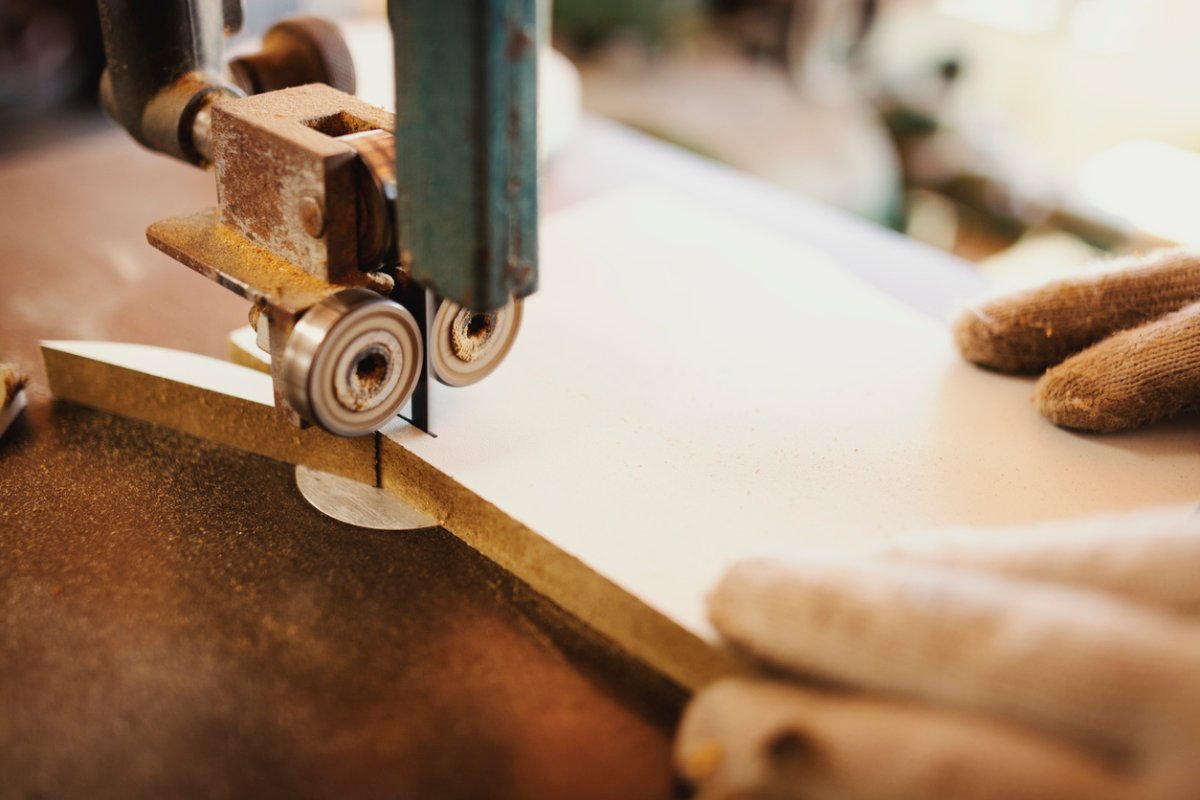
Aside from choosing between floor-standing, benchtop, and portable models, shoppers need to consider several other critical factors, including the saw’s power, its dust collection system, and blade compatibility. Keep the following considerations in mind as you shop for an integral item in the quiver of the best woodworking tools.
Types of Band Saws
Much like most table saws, users can choose from three types of band saws depending on the cutting capabilities: floor-standing, portable, and benchtop. Each style comes with advantages and disadvantages, so be sure to take the following points into consideration when shopping for the best band saw.
Floor-standing
Floor-standing band saws work best in a full-fledged shop with plenty of floor space. As the name suggests, these saws sit on the floor on top of a set of legs or a stand. They’ll sit anywhere in the shop that space allows.
Floor-standing band saws provide plenty of flexibility for maneuvering longer pieces around the saw. They may also accept larger boards or workpieces, but not always.
Benchtop
Benchtop band saws make great options in small garages or workshops with limited space. These band saws sit on top of an existing work surface like a bench or assembly table when in use and conveniently store away when not in use.
A big advantage of a bandsaw benchtop over floor-standing units is that they take up less floor space. However, they require considerable space on a workbench. And not all DIYers have the shelf space to store a band saw when they’re not using it. Those who infrequently use a band saw might wind up losing valuable workbench space for a part-time tool.
Portable
When it comes to taking a band saw to the job site or directly to the project, you can’t beat a portable band saw. These saws run on batteries or plug directly into the electrical supply to bring the cutting power right where it’s needed.
In general, most portable band saws weigh less than 12 pounds, which makes them easy to transport. They usually cut around 300 feet per minute and can typically manage pipes and beams of up to 5 inches wide.
Horsepower
As with almost all power tools, horsepower matters. DIYers and pros need a saw that will cut through the materials they use most often without bogging down or coming to a halt. Saw blades generate a lot of friction, particularly with thicker materials, and an underpowered saw won’t get the job done.
Most band saws have electric motors that produce between .5 and 1.5 horsepower. You can complete lighter-duty projects with a .5-horsepower saw, but heavy-duty work requires more power. If you want to saw hunks of hardwood into boards for woodworking projects, look for a saw that has between 1 and 1.5 horsepower.
Frame
Before landing on the best band saw for a workshop, DIYers need to consider construction. Be sure that the cast-iron or steel frame of the saw will last through the projects you plan to undertake, as it’s the one part of the saw that can’t be replaced.
In general, the best band saws have cast-iron frames. Cast iron makes for a solid and durable, albeit very heavy, frame. Unlikely to break or bend, these frames maintain the necessary tension on the saw band.
Some band saw frames come in die-cast or welded steel. A less expensive option, this type of metal weighs less and won’t last as long.
Throat
Throat size, an important measurement, refers to the distance between the blade and the band saw’s cast-iron or steel frame. It determines how wide a cut-off the saw can make. It also indicates how much space you have to maneuver a workpiece on the worktable for scrollwork and other intricate or complicated cuts. When you look for a band saw for a workshop, you’ll see throat sizes prominently listed on the side of every box.
Blade Width
To get the most out of a band saw, choose one that accepts different blade widths. Ideally, a range of ⅛ inch to 1 inch wide will handle most tasks from wood and metalworking to crafts and scrollwork. The right blade width makes tasks easier. For example, a wider saw blade allows for making straighter, truer resaws on chunks of hardwood, while thinner blades make scrolling cuts and curves a much easier process.
Weight
Weight matters a lot when it comes to the best band saws. A saw must be heavy enough to stand its ground while the user passes stubborn materials through the blade. In the case of a benchtop model, it also needs to be light enough to store when not in use.
Some older saws weigh more than 200 pounds. While a saw that heavy might not be necessary, the weight makes it very sturdy. As far as a benchtop model goes, DIYers should choose the heaviest benchtop model that they can lift. This will ensure it stays put while in use and that they can move it off of a workbench when the job wraps up.
Dust Collection
Dust collection with band saws can be a hot-button topic. Because band saws don’t generate the kind of rpm that circular or miter saws do, they don’t send sawdust or metal shavings flying toward a dust-collection port. Dust tends to accumulate slowly inside and rarely makes it to the dust-collection port that can be attached to a shop vacuum, often located at the bottom of the saw.
To make sure a band saw’s dust collection works as efficiently as possible, be sure that it comes with the correct size of couplings to adapt to existing dust collection systems or a shop vacuum.
Safety Features
Even though band saws represent old-school power tool technology, today’s models have some band saw safety-related updates. Features such as oversize stop buttons and adjustable blade guards help make floor-standing and benchtop models safer, while trigger safeties keep portable band saws from activating accidentally.
Floor-standing and benchtop models may also benefit from sliding bevel and tension gauges, as they’ll sit securely in a groove and allow for accurate cuts while keeping hands clear from the blade.
Also, for those with junior workshop partners walking around, removable keys for power switches keep children from activating a saw by accident.
FAQs
Now that you know more about band saws and the most important features to consider, you may still have questions about the tools. Below you’ll find answers to some of the most frequently asked questions about how band saws work. If you still have questions, reach out to your saw’s manufacturer and speak to a customer service representative.
Band saws are made to cut through materials including wood and metal but do not perform well on materials that are harder. Jigsaws, however, are all-purpose machines that come with variable-speed control and heavy-duty blades, making them suitable for more heavy-duty cutting tasks. Jigsaws are also capable of making straight cuts easily since they are typically faster than a band saw.
Yes, you can cut metal with a band saw. In many cases, band saws are actually the best way to cut metal. When cutting metal, it’s important to fit the saw with a metal saw band.
Milwaukee Electric Tool Company came out with two generations of batteries that provide 18 volts of power: the V18 and M18. The V18 batteries were introduced in 2006. The M18 series of batteries rolled out in 2008 and the RedLithium version of M18 were introduced a few years later.
Because brands like Milwaukee offer versions of the same voltage batteries, it’s important to check which type of battery a tool is designed to use. Typically, new batteries are not compatible with earlier generations, but many early-generation batteries can be compatible with later generations of tools.
You might need a different saw band for different materials and different types of cuts. Resawing chunks of hardwood into usable boards might require a ripping band, while you can make most other cuts with an all-purpose blade.
Blades meant for cutting metal have many more teeth per inch than those meant for wood, so it’s essential to match the right blade to the right material.
The blade and teeth of a band saw must be cleaned regularly to remove any debris, and the blade tension needs to be high enough to avoid breaking the blade. You will also want to apply cutting fluids or lubricants that keep the machine in working order. Finally, users will frequently want to verify that the blade’s guides are aligned and in place to avoid any accidental cutting.
Always keep fingers at least 2 to 3 inches away from the band saw blade when it is operational. Also ensure that a band saw is not started if it is in contact with a surface. Any potential user will also want to hold the saw firmly and feed it precisely when cutting, never forcing materials too harshly through the blade.
The easiest way to sharpen band saw teeth is with a file. Hold the file parallel to the saw’s cutting edge and make a few careful passes to put a fresh edge on the front of each tooth.
Teeth per inch (TPI) refers to the number of teeth within 1 inch of the blade’s length. Blades meant for metalworking will have higher TPI ratings from 6 to 24 TPI. Blades for cutting wood will have lower TPIs from 3 to 6 TPI.
